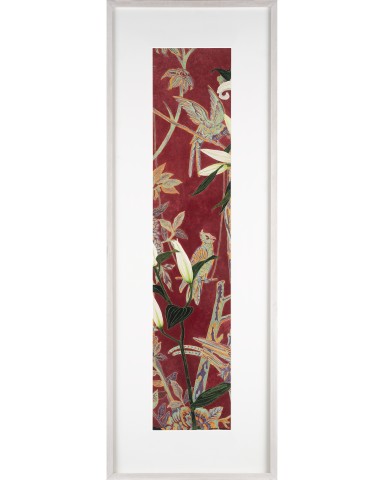LILIES AND PARROT SHAWL, 2006
CRESSIDA CAMPBELL
unique colour woodblock print
119.5 x 25.0 cm (image)
130.5 x 45.5 cm (sheet)
signed lower right: Cressida Campbell
signed below image lower left: Cressida Campbell
Rex Irwin Art Dealer, Sydney
Private collection, Sydney, acquired from the above in 2007
Cressida Campbell, Rex Irwin Art Dealer, Sydney, 9 October – 3 November 2007, cat. 30
Within this long and narrow scroll-like composition, Cressida Campbell’s unopened lilies vie for attention against shimming, multicoloured parrots frozen in the silk threads of the background drapery. A tightly cropped asymmetric sliver of a still life arrangement, printed in sumptuous pigments in a unique impression, Lilies and Parrot Shawl, 2006 becomes an artistic exercise in competing patterns and modes of pictorial representation. The artist winks at the mythological origins of painting, in which the ancient Greek Zeuxis tricks birds with his realistic depiction of a bunch of grapes. Here, Campbell’s parrots are the ones who have been artistically stylised, embroidered into richly coloured silk, carved and then painted, while the recurring white lilies of her still lives, although appearing in realistic detail in comparison, are tantalisingly truncated.
Lilies and Parrot Shawl is closely related to a larger still life composition – Still Life with Lilies and Ranunculus, of the same year – also created with her signature mirrored process of incised woodblock and its unique printed impression. In contrast to the larger composition which includes a table and places the titular flowers in vases, Campbell’s narrow focus on one sprig of blooms set against a patterned fabric emphasises the screen-like shallow pictorial space for which she is so well-known. By sharing oblique views and isolating often overlooked details, Campbell conjures a sense of shared intimacy with her viewers. Although sculptural white lilies feature habitually in her still lives and interiors (from early works such as Lilies with Indian Cloth, 1994 to Lilies with Yellow Plate and Interior with White Lilies, 2003), here, for a brief suspended moment, the closed blooms do not distract from the magnificence of the woven leaves, branches and plumed parrots of the Indian shawl.
Long before Campbell overtly described this process in the title of a work (Journey Around My Room, 2019), she created images that gently coax viewers to travel through time and space, living vicariously through the artist and her personal recollections, both known and imagined. To collect is to travel, and the artist displays clearly her love for the objects in her collection through her careful attention. She explained this impetus in 1997 ‘things that I love, if I have not made them into a picture, I feel I have not fully experienced them.’1 The artist displays in her home (and in her artworks) these collections of artworks and ceramics. She also collects textiles, most acquired or borrowed from her sister, Sally, who deals in handmade Indian textiles.2 These bolts of fabric, delicately or boldly patterned, are regularly used by the artist as stimulating backgrounds for still-life compositions, placed as tablecloths on horizontal surfaces, or, as in this composition, hung in a screen behind a floral arrangement.
A quiet achiever, Cressida Campbell has charmed Australian art lovers for over four decades, staying steadfastly true to her artistic vision and laboriously producing complex artworks of serene and seductive still lives, interiors and landscape views. Working at the intersection of painting and printmaking, she conjures beautiful unique images whose often prosaic subject matter conceals their meticulous conception. These works, on paper and on painted woodblock, are testaments to Campbell’s sophisticated visual intelligence and unwavering dedication to her artistic practice. With their unassuming beauty, they cannot help but remind us to slow down and to appreciate the visual beauty present in the everyday.
1. Campbell, cited in Wright, M., ‘Arts’, Australian Financial Review Magazine, Sydney, 26 September 1997, p. 112
2. Campbell, Interview with Rebecca Edwards, ‘Cressida Campbell and the Art of Collecting’, Cressida Campbell, National Gallery of Australia, Canberra, 2022, p. 48
LUCIE REEVES-SMITH


